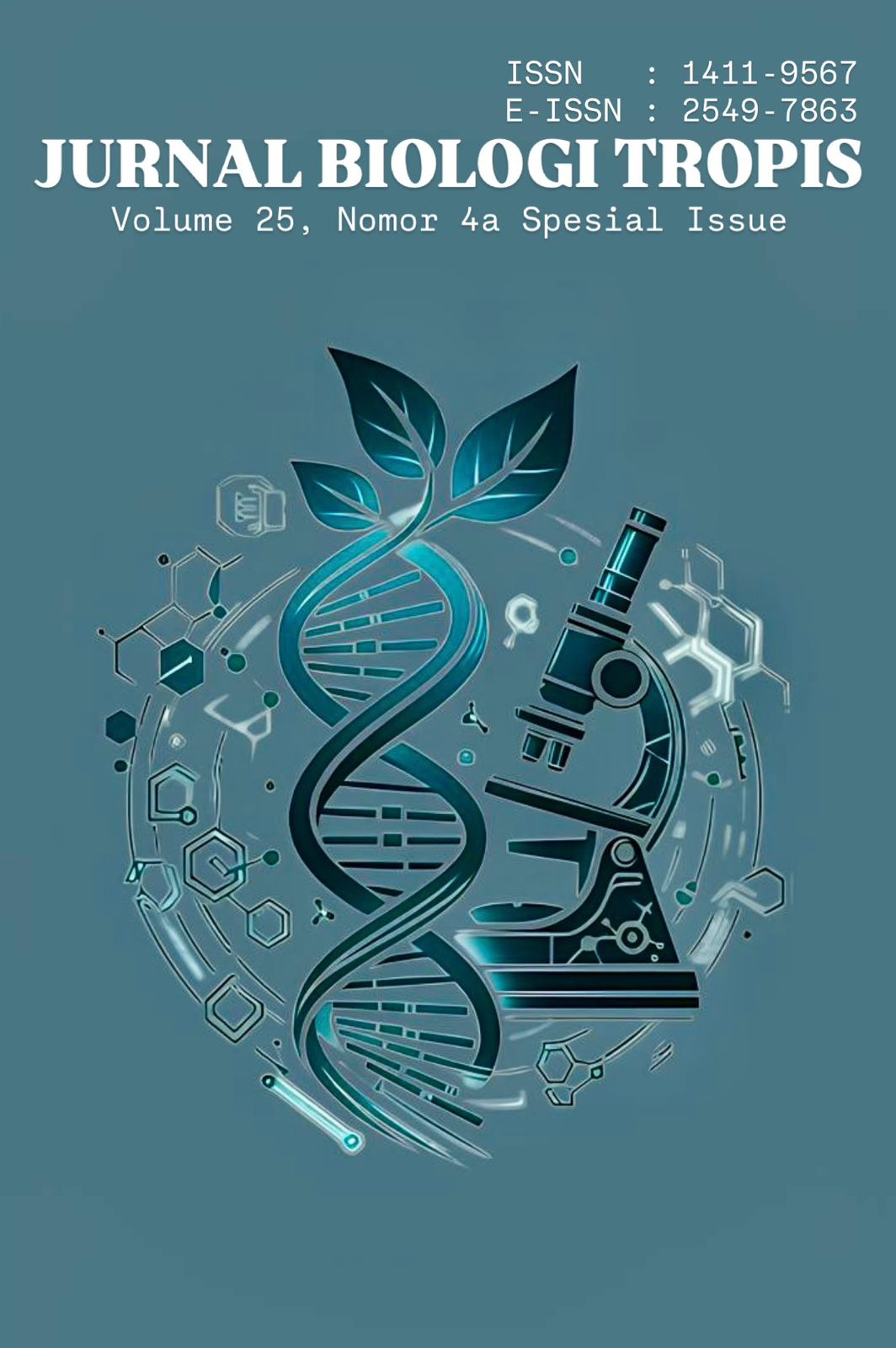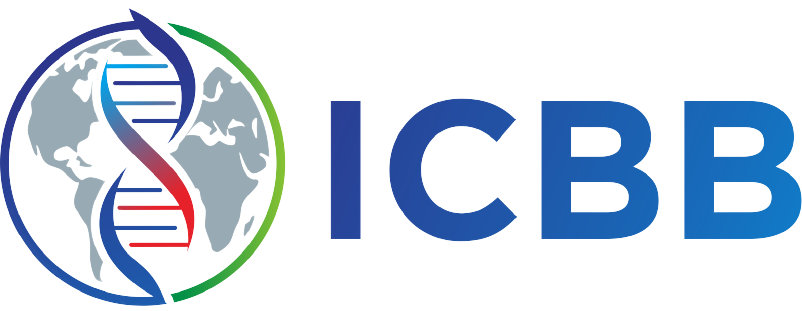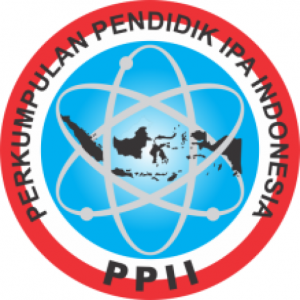Analysis of Genetic Diversity of Sago Population in Meranti Islands Based on Morphological Characteristics and Start Codon Targeted Polymorphism (SCoT) and matK Marker
Authors
Pradnya Paramita , Deviona Deviona , Herman HermanDOI:
10.29303/jbt.v25i4a.10624Published:
2025-11-07Issue:
Vol. 25 No. 4a (2025): Special IssueKeywords:
Sago, ScoT, MatK, DNA MarkerArticles
Downloads
How to Cite
Downloads
Metrics
Abstract
Sago is an iconic agricultural commodity from the Meranti Islands region. Sago plantations cover 40,386 hectares. Diverse production yields and morphological differences in sago populations indicate high genetic diversity. This study aims to identify sago plants in the Meranti Islands and classify them based on similarities in morphological traits and DNA analysis. DNA analysis was carried out using SCoT and MatK markers. The research stages included sample collection, total DNA isolation, total DNA electrophoresis, total DNA amplification with SCoT and MatK primers, and data analysis. The results showed that based on morphological traits, sago populations in the Meranti Islands consist of three groups: BB, TB, and BJ. The dendrogram generated from the analysis of binary data SCoT using the UPGMA method and MatK analysis using BLAST in Genebank showed that these three groups are distinct and have different similarity coefficients. The BB group has a higher similarity coefficient with the BJ group compared to the TB group. There is no high genetic variation within these groups due to vegetative propagation of sago.
References
Abbas, B., Kabes, R. J., Tjolli, I., Wibowo, K., & Richana, N. (2020). Feasibility Study Penerapan Hasil Riset Berbasis Sagu.
Afzal, I., Shabir, R., & Rauf, S. (2019). Seed production technologies of some major field crops. In Agronomic Crops: Volume 1: Production Technologies (pp. 655-678). Singapore: Springer Singapore. 10.1007/978-981-32-9151-5_28
Anggini, R. (2019). Kekerabatan Genetik Pulasan (Nephelium Ramboutan-Ake (Labill.) Leenh) Di Kabupaten Siak Dan Bengkalis Berdasarkan Penanda RAPD (Random Amplified Polymorphic DNA) (Doctoral dissertation, Universitas Islam Riau).
Aulia, A. (2022). Studi In Silico Potensi DNA Barcode Berbasis DNA Kloroplas (CpDNA) untuk Identifikasi Variasi Genetik Opuntia sp. Jurnal Syntax Admiration, 3(11), 1383-1394. https://doi.org/10.46799/jsa.v3i11.512
Azizah, M. I., Mulyani, R., Hartati, Y. W., & Maksum, I. P. (2024). Mutasi pada DNA Mitokondria dan Pengaruhnya terhadap Diabetes Melitus Tipe 2 dan Kompleks Forforilasi Oksidatif. Chimica et Natura Acta, 12(2), 128-137. https://doi.org/10.24198/cna.v12.n2.49970
Bidyananda, N., Jamir, I., Nowakowska, K., Varte, V., Vendrame, W. A., Devi, R. S., & Nongdam, P. (2024). Plant genetic diversity studies: insights from DNA marker analyses. International Journal of Plant Biology, 15(3), 607-640. https://doi.org/10.24198/cna.v12.n2.49970
Chesnokov, Y. V., Kosolapov, V. M., & Savchenko, I. V. (2020). Morphological genetic markers in plants. Russian Journal of Genetics, 56(12), 1406-1415. 10.1134/S1022795420120042
Collard, B.C. and Mackill, D.J. (2009) Start Codon Targeted (SCoT) Polymorphism: A Simple Novel DNA Marker Technique for Generating Gene-Targeted Markers in Plants. Plant Molecular Biology Reporter 27: 86-93. https://link.springer.com/article/10.1007/s11105-008-0060-5
Gusmiaty, G., Sari, N. A., Safira, T. N., Budiman, A., & Larekeng, S. H. (2021). Polimorfisme Penanda Rapd Untuk Analisis Keragaman Genetik Kemiri (Aleurites Mollucana) Di Kabupaten Maros. Bioma: Jurnal Biologi Makassar, 6(1), 22-30. 10.20956/bioma.v6i1.11814
Hapsari, R., Trustinah, I. R., & Iswanto, R. (2015). Keragaman plasma nutfah kacang hijau dan potensinya untuk program pemuliaan kacang hijau. In Prosiding Seminar Nasional Masyarakat Biodiversitas Indonesia (Vol. 1, No. 4, pp. 918-922). 10.13057/psnmbi/m010447
Hasan, M., Nazar, M., Utami, A., Khairani, C. P., Nafilah, F., Parma, R., ... & Tuddin, H. (2022). Bioplastik untuk pengemas makanan berbasis pati dan kitosan. Bandar Publishing.
Husna, N. (2017). Pemberdayaan Masyarakat Pedesaan di Daerah Tertinggal Melalui Pengembangan Tanaman Sagu. Lembaran Masyarakat: Jurnal Pengembangan Masyarakat Islam, 3(2), 154-168. 10.32678/lbrmasy.v3i2.1875
Kress, W. J., & Erickson, D. L. (2012). DNA barcodes: methods and protocols. In DNA barcodes: Methods and protocols (pp. 3-8). Totowa, NJ: Humana Press.
Kusumawaty, Y., Harahap, H., Rasyid, T. H., Syahputra, H. W., Hadi, S., Seygita, V., ... & Noviana, I. M. P. (2024). Potensi Tanaman Sagu di Sentra Produksi Kabupaten Kepulauan Meranti dan Indragiri Hilir Provinsi Riau sebagai Sumber Karbohidrat Lokal. IPTEKIN Jurnal Kebijakan Pembangunan dan Inovasi, 6(2), 53-64. https://jurnal.riau.go.id/iptekin/article/view/88
Kuzmina, M. L., Johnson, K. L., Barron, H. R., & Hebert, P. D. (2012). Identification of the vascular plants of Churchill, Manitoba, using a DNA barcode library. BMC ecology, 12(1), 25. https://bmcecol.biomedcentral.com/articles/10.1186/1472-6785-12-25
Lestari, S. U., & Julianto, R. P. D. (2020). Analisis keragaman genetik dan kekerabatan genotipe ubi jalar berdasarkan karakter morfologi. Buletin Palawija, 18(2), 113-122. 10.21082/bulpa.v18n2.2020.p113-122
Martiansyah, I. (2021). Mini Review: Pendekatan molekuler DNA barcoding: Studi kasus identifikasi dan analisis filogenetik Syzygium (Myrtaceae). In Prosiding Seminar Nasional Biologi (Vol. 7, No. 1, pp. 187-195).
Mukhopadhyay, N., Noble, J. A., Govil, M., Marazita, M. L., & Greenberg, D. A. (2018). Identifying genetic risk loci for diabetic complications and showing evidence for heterogeneity of type 1 diabetes based on complications risk. PloS one, 13(2), e0192696. https://doi.org/10.1371/journal.pone.0192696
Muzzazinah. (2017). Metode filogenetik pada indigofera. Prosiding Seminar Nasional Pendidikan Biologi Dan Biologi, 25-40.
Nishimaki, T., & Sato, K. (2019). An extension of the Kimura two-parameter model to the natural evolutionary process. Journal of molecular evolution, 87(1), 60-67. 10.1007/s00239-018-9885-1
Pembayun, P., Karmanah, K., & Djoefrie, M. H. B. (2024). Karakter Morfologi dan Produksi Pati Sagu (Metroxylon spp.) di Kecamatan Tinombo Selatan, Sulawesi Tengah. Agrisintech (Journal of Agribusiness and Agrotechnology), 5(2), 57-64. https://ejournalunb.ac.id/AGRI/article/view/723
Pratama, R., Windusari, Y., Hanum, L., Palupi, R., Imsya, A., Nofyan, E., & Oktapia, M. (2021). Characteristic of local swamp buffalo (Bubalis bubalis Linn.) genetic variations in Rambutan sub-district, South Sumatra based on polymerase chain reaction-random amplified polymorphic DNA (PCR RAPD).
Roslim, D.I, Herman, Adiwirman, Wahyu Lestari. (2023). Barkoding DNA. KBM Indonesia.Yogyakarta
Rosmaina, R., & Zulfahmi, Z. (2013). Genetic diversity of Eurycoma longifolia Jack based on random amplified polymorphic DNA marker. Jurnal Manajemen Hutan Tropika, 19(2), 138-144. https://doi.org/10.7226/jtfm.19.2.138
Sari, S. K., Listyorini, D., Mazieda, M. N., & Sulasmi, E. S. (2014). Optimasi teknik isolasi dan purifikasi DNA pada daun cabai rawit (Capsicum frutescens cv. Cakra Hijau) menggunakan Genomic DNA Mini Kit (Plant) GENEAID. In Proceeding Biology Education Conference: Biology, Science, Enviromental, and Learning (Vol. 11, No. 1, pp. 65-70). https://jurnal.uns.ac.id/prosbi/article/view/7660
Sogandi, S., & Sagala, Z. (2022). DNA Barcoding Tanaman Mangga Kasturi (Mangifera casturi) Asal Kalimantan Selatan Berbasis DNA Kloroplas Gen rbcL dan matK. Jurnal Ilmu Kefarmasian Indonesia, 20(1), 38-43. 10.35814/jifi.v20i1.1045
Su’udi, M., Ramadany, Z., Rohimah, S., Arum, A. Y., Setyati, D., & Ulum, F. B. (2023). Peran Mini-Barcode Internal Transcribed Spacer 2 (ITS2) untuk Identifikasi Molekuler Spesies Anggrek. Indonesian Journal of Biotechnology and Biodiversity, 7(1), 34-45. https://doi.org/10.47007/ijobb.v7i1.166
Subari, A., Razak, A., & Sumarmin, R. (2021). Phylogenetic analysis of Rasbora spp. based on the mitochondrial DNA COI gene in Harapan Forest. Jurnal Biologi Tropis, 21(1), 89-94. 10.29303/jbt.v21i1.2351
License
Copyright (c) 2025 Pradnya Paramita, Deviona Deviona, Herman Herman

This work is licensed under a Creative Commons Attribution 4.0 International License.

Jurnal Biologi Tropis is licensed under a Creative Commons Attribution 4.0 International License.
The copyright of the received article shall be assigned to the author as the owner of the paper. The intended copyright includes the right to publish the article in various forms (including reprints). The journal maintains the publishing rights to the published articles.
Authors are permitted to disseminate published articles by sharing the link/DOI of the article at the journal. Authors are allowed to use their articles for any legal purposes deemed necessary without written permission from the journal with an acknowledgment of initial publication to this journal.


























